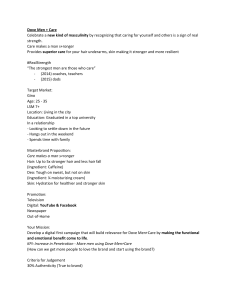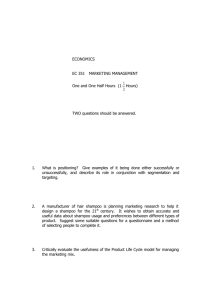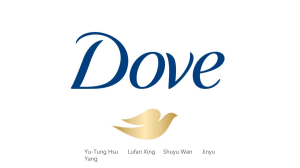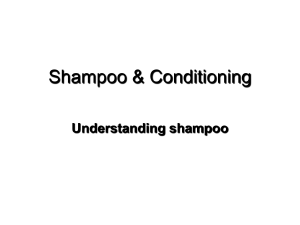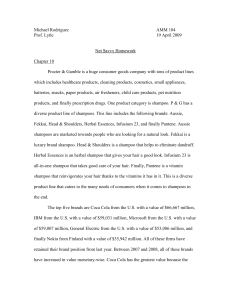Hindustan Unilever Dove Brand Case Study
advertisement
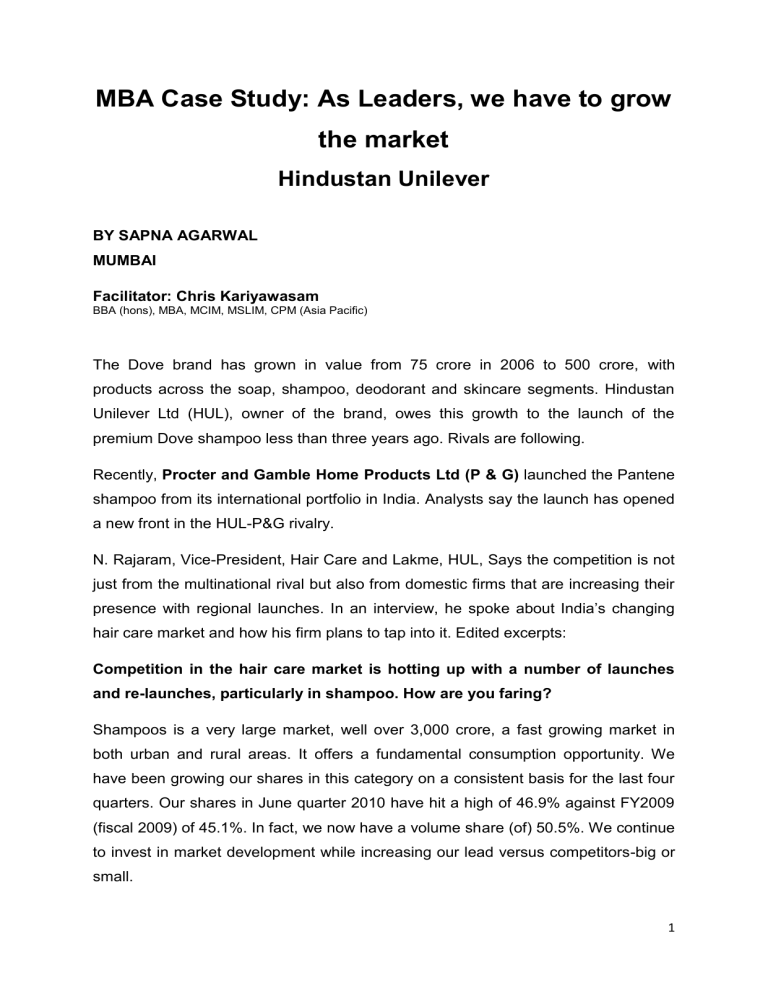
MBA Case Study: As Leaders, we have to grow the market Hindustan Unilever BY SAPNA AGARWAL MUMBAI Facilitator: Chris Kariyawasam BBA (hons), MBA, MCIM, MSLIM, CPM (Asia Pacific) The Dove brand has grown in value from 75 crore in 2006 to 500 crore, with products across the soap, shampoo, deodorant and skincare segments. Hindustan Unilever Ltd (HUL), owner of the brand, owes this growth to the launch of the premium Dove shampoo less than three years ago. Rivals are following. Recently, Procter and Gamble Home Products Ltd (P & G) launched the Pantene shampoo from its international portfolio in India. Analysts say the launch has opened a new front in the HUL-P&G rivalry. N. Rajaram, Vice-President, Hair Care and Lakme, HUL, Says the competition is not just from the multinational rival but also from domestic firms that are increasing their presence with regional launches. In an interview, he spoke about India’s changing hair care market and how his firm plans to tap into it. Edited excerpts: Competition in the hair care market is hotting up with a number of launches and re-launches, particularly in shampoo. How are you faring? Shampoos is a very large market, well over 3,000 crore, a fast growing market in both urban and rural areas. It offers a fundamental consumption opportunity. We have been growing our shares in this category on a consistent basis for the last four quarters. Our shares in June quarter 2010 have hit a high of 46.9% against FY2009 (fiscal 2009) of 45.1%. In fact, we now have a volume share (of) 50.5%. We continue to invest in market development while increasing our lead versus competitors-big or small. 1 How do you explain this growth? .....Take the urban market. Over the years, the market has fragmented from the generic kaale ghane baal (dark, thick hair) market to speak about a sharper concept of damage, dryness, breakage of hair, The SEC, a well-educated, senior professional category woman was willing to look at these issues. These are women who are willing to pay a premium if they see value and benefit; it’s just 20% premium to the next competitor. Against the average it is just 1.2 to two times-against an average shampoo at 60, it is just 110. Dove spoke of these issues and in a short span of three years, we have 10% share in urban India in JQ 10 (June quarter, 2010). This translates to a 200 crore brand in hair care (including shampoos and conditioners) in just three years. It is the largest hair care brand in modern trade channel across India, with 18.3% market share. Where do you see opportunity for further growth? The opportunity is both urban and rural. The other end of the market, where we are significantly investing, is shampoo sachets, which is the rural part of it. Close to 6070% of volumes come from sachets. The split in value market share is 60:40 between urban and rural (areas). We will continue to grow the lower end of the market as well. Our biggest brand, Clinic Plus, which is the market leader in shampoos, was relaunched with a significantly improved mix in August 2009. We are already seeing our highest shares in Clinic Plus at 21.1% in June quarter versus 19.7% in Fiscal 2009. The opportunity is to really get people to consume more. In three words, it is more users, more usage and more benefits. Those are the three fundamental ways around which our plans are designed. 2 How are you addressing this Changed market? Some years ago, penetration was the key task. People had to be told or explained that they try this product. We have now moved beyond that. It’s now about what is the benefit of using this product more often or using it the right way. That’s the next big learning for us. We are very well positioned because we have the right portfolio of brands and we are operating at various price points. So it allows us to give value proposition for everybody at the right price point. Do you expect the competition to get tougher? Our competitor at rural India is very different from urban India. There are India. There are new players that are coming in. We are not obsessed with just one competitor.... As leaders, we have the responsibility to grow the market as well. The consumer is now getting more and more choices. People are coming up with similar kind of benefits.... There is an effort to grow new categories. There are players who are going to come in and more launches even at the low end (will take place) There are not too many new competitors; the product offerings to do justice to your consumer base then we need to have more products. What are the growth areas for you in the urban market? The hair conditioner business is the market of the future. In many markets, conditioners Is: about one-third of the shampoo market. In India, it is virtually next to nothing. This is a 200 crore category today and growing at 40% to 50%. The category was non-existent three-four years ago. We are the market leaders in this category. While we are doing well in market share, our eye really is on building the market. That is the big opportunity. This will translate into other opportunities like serums, masks and treatments. We have all this in Dove and will build these markets one at a time as well. 3 And in the rural market..? Rural market is a key opportunity for consumption building. There is an opportunity to educate consumers to use more. In terms of having tried shampoo or knowing what shampoo does, there is an 80% penetration. In the course of the last one year, 80% of consumers would have tried shampoo. The point is: Are they buying the next week, month, quarter? Over here, it is not about benefits like damaged hair. Many of them have to be taught how to use the products. The good thing is that here, consumers are willing to embrace a regime if they see a benefit and value. We are running one of our largest consumer connect initiatives here-Khushiyon Ki Doli. It allows (us) to go deeper, to villages that are media dark with populations of 5,000 people. Close to 30-40% of rular UP (Uttar Pradesh) is media dark. The commitment is to build (sales) in media dark villages, which are the markets of the future. Group Discussion Questions: 1. How did Unilever grow the Dove brand? 2. What were the key consumer insights identified? 3. Identify the basis (source(s) of value creation) on which the Dove brand generated competitive advantage. 4. Identify the market segmentation for Dove 5. With reference to key performance indicators (KPIs) evaluate the current marketing strategy of Hindustan Unilever 6. What do you think would be the consequences of not doing New Product Development on market share of Dove? 7. As members of the Management Committee of Hindustan Unilever (HUL) what are your recommendations to continue the growth momentum of Dove in the next two years? 4
